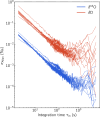An East Antarctic, sub-annual resolution water isotope record from the Mount Brown South Ice core
- PMID: 39256407
- PMCID: PMC11387611
- DOI: 10.1038/s41597-024-03751-w
An East Antarctic, sub-annual resolution water isotope record from the Mount Brown South Ice core
Abstract
We report high resolution measurements of the stable water isotope ratios (δ18O, δD) from the Mount Brown South ice core (MBS, 69.11° S 86.31° E). The record covers the period 873 - 2009 CE with sub-annual temporal resolution. Preliminary analyses of surface cores have shown the Mount Brown South site has relatively high annual snowfall accumulation (0.3 metres ice equivalent) with a seasonal bias toward lower snowfall during austral summer. Precipitation at the site is frequently related to intense, short term synoptic scale events from the mid-latitudes of the southern Indian Ocean. Higher snowfall regimes are associated with easterly winds, while lower snowfall regimes are associated with south-easterly winds. Isotope ratios are measured with Infra-Red Cavity Ring Down Spectroscopy, calibrated on the VSMOW/SLAP scale and reported on the MBS2023 time scale interpolated accordingly. We provide estimates for measurement precision and internal accuracy for δ18O and δD.
© 2024. The Author(s).
Conflict of interest statement
The authors declare no competing interests.
Figures















References
-
- Van Ommen, T. D., Morgan, V. & Curran, M. A. J. Deglacial and Holocene changes in accumulation at Law Dome, East Antarctica. Annals of Glaciology39, 359–365, 10.3189/172756404781814221 (2004).10.3189/172756404781814221 - DOI
-
- Roberts, J. et al. A 2000-year annual record of snow accumulation rates for Law Dome, East Antarctica. Clim. Past11, 697–707, 10.5194/cp-11-697-2015 (2015).10.5194/cp-11-697-2015 - DOI
Grants and funding
LinkOut - more resources
Full Text Sources

